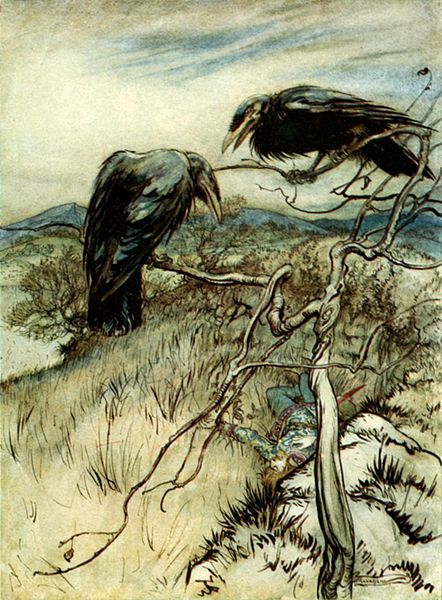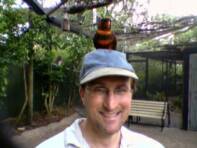Linguistics
A Murder of Crows
Group Names for Birds
by Terry Ross
Group Names for Birds: A Partial List
A bevy of quail
A bouquet of pheasants [when flushed]
A brood of hens
A building of rooks
A cast of hawks [or falcons]
A charm of finches
A colony of penguins
A company of parrots
A congregation of plovers
A cover of coots
A covey of partridges [or grouse or ptarmigans]
A deceit of lapwings
A descent of woodpeckers
A dissimulation of birds
A dole of doves
An exaltation of larks
A fall of woodcocks
A flight of swallows [or doves, goshawks, or cormorants]
A gaggle of geese [wild or domesticated]
A host of sparrows
A kettle of hawks [riding a thermal]
A murmuration of starlings
A murder of crows
A muster of storks
A nye of pheasants [on the ground]
An ostentation of peacocks
A paddling of ducks [on the water]
A parliament of owls
A party of jays
A peep of chickens
A pitying of turtledoves
A raft of ducks
A rafter of turkeys
A siege of herons
A skein of geese [in flight]
A sord of mallards
A spring of teal
A tidings of magpies
A trip of dotterel
An unkindness of ravens
A watch of nightingales
A wedge of swans [or geese, flying in a "V"]
A wisp of snipe
Any of these group names may properly be used by birders who wish to display their erudition, although it is probably linguistically inaccurate (and it certainly is bad manners) to upbraid someone who refers to "a bunch of ravens" by saying, "Surely you mean `an unkindness of ravens,' my good fellow." Most of these terms date back at least 500 years. Some of them have been in continuous use since then; others have gone out of fashion and been resurrected in the last century or two; still others only exist on lists.
Most of these terms are listed in James Lipton's An Exaltation of Larks. Lipton's list is substantially based on very old sources. There were manuscript lists of group names in the 15th century, and these lists appeared in some of the first books printed in England. Many of them make their first appearance in John Lydgate's Debate between the Horse, Goose, and Sheep (1440); and Lydgate's terms along with others appear in The Book of Hawking and Hunting (also known as The Book of St. Albans) by Dame Juliana Barnes (1486). Whether Lydgate and Barnes coined any of these terms, or whether they were setting down the terms that were considered proper in their day is not known. Many of the terms did catch on, and the lists they appeared on were frequently reprinted.
The best source I know for investigating the histories of English words is the Oxford English Dictionary. Unfortunately, on the question whether these terms ever were or still are appropriate, the OED is not entirely helpful. To make sense of the matter, I have placed the group names into groups--
GROUP A--The following group names are standard:
GROUP B--These terms are not group names for a particular type of bird,
but have been commonly used for many different types:
GROUP C--These terms are archaic; they were once obsolete, but they have
been revived somewhat in the 19th or 20th centuries:
GROUP D--These terms are obsolete; they appeared on the old lists, but
almost nobody has used them in centuries:
GROUP E--These terms are not in the OED at all as group names for birds:
My categories are imprecise, but they provide some guidance about usage. Have no qualms about using any of the terms in group A; use the terms in group B for any group of birds that seems apt; use the terms in groups C and D only if you don't mind being thought pedantic or literary; avoid the terms in group E unless you know something the OED doesn't.
Alas, the OED itself is not totally reliable: the word "kettle" (as both a noun and a verb) has been used by hawk watchers for many years, and it has often appeared in print; the OED editors obviously are not birders. It may well be that the other terms in group E appear on the 15th-century lists and were simply missed.
© 2009 Moronic Ox Literary Journal - Escape Media Publishers / Open Books
Moronic Ox Literary and Cultural Journal - Escape Media Publishers / Open Books Advertise your book, CD, or cause in the 'Ox'
Novel Excerpts, Short Stories, Poetry, Multimedia, Current Affairs, Book Reviews, Photo Essays, Visual Arts Submissions
a quarterly literary anthology of
contest stories
"The Twa Corbies" (or The Two Ravens)
Arthur Rackham: “Some British Ballads” (1919)


Life, death and the relationships we forge between.
The Courage of Intimacy
is a collection of modern poetry exploring the fundamental human need to connect
with others.
About the Poet:
Born in 1965, educated at Tufts University witha B.S. in English Literature, Biology and Environ-
mental Studies with a law degree from the University of Miami, Keith Ainsworth is an environmental attorney residing on the New England shoreline with his family. An ardent environmentalist, Keith frequently represents environmental conservation interests.


